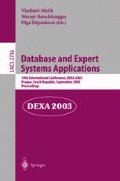Abstract
Mobile agents are software entities consisting of code and data that can migrate autonomously from host to host executing their code. Despite its benefits, security issues strongly restrict the use of code mobility. The protection of mobile agents against the attacks of malicious hosts is considered the most difficult security problem to solve in mobile agent systems.
The approach that is presented here detects manipulation attacks performed during the agent’s execution. Software watermarking techniques are used in order to embed a mark into the agent. The agent’s execution creates marked results. When the agent returns to the origin host, these results are examined in order to find the embedded mark. If the mark has changed, this means that the executing host has modified the agent. Colluding hosts can also be identified by using codes with the identifiable parent property (IPP) as marks, i.e. mobile agent fingerprinting.
Access this chapter
Tax calculation will be finalised at checkout
Purchases are for personal use only
Preview
Unable to display preview. Download preview PDF.
References
Collberg, C., Thomborson, C.: Software watermarking: Models and dynamic embeddings. In: Principles of Programming Languages 1999, POPL 1999 (1999)
Collberg, C., Thomborson, C., Low, D.: A taxonomy of obfuscating transformations. Technical Report 148, The University of Auckland (1997)
Esparza, O., Soriano, M., Muñoz, J.L., Forné, J.: Host Revocation Authority: a Way of Protecting Mobile Agents from Malicious Hosts. In: Cueva Lovelle, J.M., Rodríguez, B.M.G., Gayo, J.E.L., Ruiz, M.d.P.P., Aguilar, L.J. (eds.) ICWE 2003. LNCS, vol. 2722. Springer, Heidelberg (2003)
Fernandez, M., Soriano, M.: Algorithm to decode identifiable parent property codes. Electronics Letters 38(12), 552–553 (2002)
Hohl, F.: Time Limited Blackbox Security: Protecting Mobile Agents From Malicious Hosts. In: Vigna, G. (ed.) Mobile Agents and Security. LNCS, vol. 1419. Springer, Heidelberg (1998)
Hollmann, H., van Lint, J., Linnartz, J., Tolhuizen, L.: On codes with the identifiable parent property. Journal of Combinatorial Theory 82(2), 121–133 (1998)
Riordan, J., Schneier, B.: Environmental Key Generation Towards Clueless Agents. In: Vigna, G. (ed.) Mobile Agents and Security. LNCS, vol. 1419. Springer, Heidelberg (1998)
Roth, V.: Mutual protection of cooperating agents. In: Secure Internet Programming: Security Issues for Mobile and Distributed Objects. LNCS, vol. 1906. Springer, Heidelberg (1999)
Sander, T., Tschudin, C.F.: Protecting mobile agents against malicious hosts. In: Vigna, G. (ed.) Mobile Agents and Security. LNCS, vol. 1419, p. 44. Springer, Heidelberg (1998)
Stern, J.P., Hachez, G., Koeune, F., Quisquater, J.J.: Robust object watermarking: Application to code. In: Pfitzmann, A. (ed.) IH 1999. LNCS, vol. 1768. Springer, Heidelberg (2000)
Vigna, G.: Cryptographic traces for mobile agents. In: Vigna, G. (ed.) Mobile Agents and Security. LNCS, vol. 1419, p. 137. Springer, Heidelberg (1998)
Yee, B.S.: A sanctuary for mobile agents. In: DARPA workshop on foundations for secure mobile code (1997)
Author information
Authors and Affiliations
Editor information
Editors and Affiliations
Rights and permissions
Copyright information
© 2003 Springer-Verlag Berlin Heidelberg
About this paper
Cite this paper
Esparza, O., Fernandez, M., Soriano, M., Muñoz, J.L., Forné, J. (2003). Mobile Agent Watermarking and Fingerprinting: Tracing Malicious Hosts. In: Mařík, V., Retschitzegger, W., Štěpánková, O. (eds) Database and Expert Systems Applications. DEXA 2003. Lecture Notes in Computer Science, vol 2736. Springer, Berlin, Heidelberg. https://doi.org/10.1007/978-3-540-45227-0_90
Download citation
DOI: https://doi.org/10.1007/978-3-540-45227-0_90
Publisher Name: Springer, Berlin, Heidelberg
Print ISBN: 978-3-540-40806-2
Online ISBN: 978-3-540-45227-0
eBook Packages: Springer Book Archive

